 |
 |
 |
 |
|
JANUARY 1941
2 January: The U.S. announced to build 200 freighters, the "Liberty ships". 10 January: The U.S. Congress started a debate on "Lend-Lease programme". 11 January: Hitler ordered the creation of the "Afrika Korps". 19 January: Hitler and Mussolini decided to cooperate on military matters. 19 January: British forces invaded Eritrea. 22 January: Tobruk (North Africa) fell to British and Australian troops. Establishment of the T4 killing centre Hadamar. |
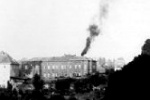 |
|
FEBRUARY 1941
4 February: The German battleships "Gneisenau" and "Scharnhorst" sneaked to the Atlantic Ocean and sank 22 Allied ships (mainly trading vessels). 6 February: Hitler ordered to change the air war into trade war. 7 February: The fall of Beda Fromm marked the end of the first British offensive in North Africa. British troops destroyed 130,000 men of the Italian 10th Army. 8 February: First German troops left Naples for North Africa. 9 February: The British warships HMS Ark Royal, HMS Renown and HMS Malaya attacked the Italian harbours Genoa, Livorno, and La Spezia. 11 February: The 5th German Light Division landed in Tripoli (North Africa). 12 February: German Generalleutnant Rommel arrived at Libya to take over the command of the German Afrika Corps. 13 February: The Nazis formed a Jewish council for the city of Amsterdam. 14 February: First units of the German "Afrika Korps" arrived in North Africa. 22 February: Outside the Warsaw Ghetto the selling of food to Jews was punished by forced labour. 22 February: 430 Jewish hostages were deported from Amsterdam after a Dutch Nazi was killed by Jews. 28 February: A Forced Labour Service ("Zwangsarbeitsdienst") was introduced in the Netherlands. |
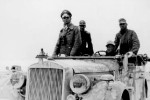 |
|
MARCH 1941
1 March: Bulgaria joined the Axis Pact; German troops entered the country. 1 March: Himmler visited Auschwitz and demanded forced labourers from KZ Auschwitz for the IG Farben Industries at Auschwitz-Monowitz. 2 March: German troops occupied Bulgaria. 3 March: The governor of the Krakow district, Dr. Otto Wächter, ordered the establishment of the Krakow Ghetto. 4 March: Start of the deployment of British troops in Greece. 4 March: British troops landed at the Lofoten Islands. 215 German soldiers captured. 7 March: German Jews were ordered into forced labor. 8 March: Martial law in North Holland. 9 March: Italian and Albanian offensive against Greece. 10 March: British forces entered Abyssinia. 11 March: Roosevelt signed the "Lend-Lease Act". 15 March: Roosevelt promised help for the European Democracies. 16 March: First successful use of radar by surface ships to sink a submarine (German U 99). 24 March: The Lublin Ghetto was established. 27 March: Military putsch in Yugoslavia. As a result a pro-Allied government was established. General Simovic became head of government. 27 March: Anti-Semitic laws in Rumania. 29 March: A "Kommissariat for Jewish Affairs" was set up in Vichy France. 30 March: Hitler announced a racial war against the Soviet Union. 31 March: The Kielce Ghetto was established. 31 March: A Nazi-operated German central office for Jewish emigration was established in the Netherlands. Announcement of the establishment of the Tarnow Ghetto. Between March and April, the Germans established two ghettos in Radom. Himmler ordered the construction of Auschwitz-Birkenau. According to Jewish sources 460,000 Jews lived in the Warsaw Ghetto. German authorities estimated the number of Jews in Warsaw on 490,000 people. |
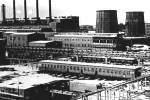 |
|
APRIL 1941
2 April: Maiden flight of the world's first jet plane Heinkel HE 280. 5 April: British troops occupied Addis Ababa, the capital of the Italian colony Abyssinia 6 April: German troops entered Greece and Yugoslavia. 6 April: Mutual assistance pact between Yugoslavia and the USSR. 8 April: 229 British bombers attacked Kiel (Germany). 8-10 April: German bombers attacked Belgrade. 9 April: Establishment of an "open" ghetto in Czestochowa. 9 April: German troops captured Thessaloniki (Greece). 9 April: 237 German bombers attacked Birmingham. 10 April: In Nazi-occupied Zagreb the new state Croatia was founded by the Ustascha movement. 12 April: Belgrade was occupied by German troops. 13 April: Nonaggression treaty between Japan and the USSR. 17 April: Yugoslavia surrendered. 19 April: British troops arrived in Iraq. 24 April: British troops retreated from Greece. 27 April: Athens was occupied by German troops. |
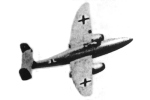 |
|
MAY 1941
1 May: Establishing of a ghetto in Zamosc. 1 May: The Netherlands: Limitations were set for employment. Jews had to surrender all radios. 2 May: Mussolini announced that Slovenia became Italian province. 5 May: Emperor Haile Selassie re-entered Addis Ababa. He returned in triumph to his country. 6 May: Stalin became official head of government of the USSR. 10 May: Hess, Hitler's deputy in the NSDAP, flew to Scotland where he tried to negotiate about peace but was interned. Hitler dismissed him from all functions. 10 May: The last heavy Luftwaffe air raids on London (500 airplanes). 13 May: Hitler promised immunity for all crimes against international law, committed by Germans against the Soviet population. 13 May: Martin Bormann became the new deputy leader of the Nazi Party NSDAP. 14 May: 3,600 Jews were arrested in Paris. 16 May: The French Marshal Petain issued a radio broadcast approving collaboration with Hitler. 18 May: The majority of the Italian troops in East Africa surrendered to British troops. 19 May: Germany released 100,000 French POWs in return for greater collaboration with Vichy France. 20 May: German paratroopers start the occupation of British-occupied Crete. 24 May: The German battleships Bismarck and the heavy cruiser Prinz Eugen sank the British battlecruiser HMS Hood. 3 out of 1416 British sailors survived. The British aircraft carrier HMS Ark Royal and the battlecruiser HMS Renown left Gibraltar to join the hunt for the Bismarck. 27 May: Roosevelt declared the national state of emergency. 27 May: The German battleship Bismarck was severely hit by British forces (battleships HMS Rodney and HMS King George V, heavy cruisers HMS Norfolk and HMS Dorsetshire) and was finally scuttled by its own crew. 118 out of 2,221 German sailors survived. 28 May: Allied troops evacuation of Crete ended. 16,500 soldiers were evacuated, most to Egypt. |
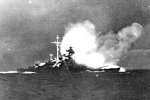 |
|
JUNE 1941
1 June: British troops entered Baghdad. 1 June: The last British troops left Crete. 4 June: The German ex-emperor Wilhelm II. died in Dutch exile. 6 June: "Kommissarbefehl": All political Soviet officers and all communist oficials should be killed. 8 June: British forces invaded Syria, and attacked Vichy French forces. 15 June: The "Nürnberger Gesetze" (Racial Laws) became valid in the occupied East European countries. 17 June: "Operation Battleaxe" (Tobruk / North Africa) ended in failure for the British troops. 22 June: "Unternehmen Barbarossa", the German invasion of the USSR, began. 22 June: Italy and Romania declared war on the USSR. 24 June: Beginning of the Lviv (Lwow) Pogrom. Hundreds of the Jews were killed on the streets and in prisons by Ukrainians. From 2 July German soldiers from the Einsatzgruppe C participated in the mass-murder. Until 6 July about 5,000 Jews were killed in the town. 25 June: Beginning of the Kovno (Kaunas) Pogrom. Lithuanians under German supervision killed about 3,800 Jews until 29 June. 27 June: First mass execution of Jews in Bialystok. About 2,000 people were killed. 27 June: Hungary declared war on the USSR. 27 June: Battle of Minsk. 29 June: The Soviet Government declared the "Great Patriotic War" to defend the country. 29 June: Finland declared war on the USSR. 30 June: Hitler moved to his headquarters "Wolfsschanze" in East Prussia. 30 June: Stalin became chief of the USSR Defence Committee. |
 |
|
JULY 1941
1 July: The RAF bombed Brest harbour (France), damaging the German battleship Prinz Eugen. 2 July: Heydrich wrote to the Higher SS and Police Leaders (HSSPF) in the occupied Soviet territory setting out the verbal instructions he had given to the Einsatzgruppen. 2 July: Pogrom in Boryslaw. About 350 Jews were killed. 2 July: Japanese troops occupied French Indochina. 3 July: After the detection of 649 corpses of NKVD victims at the prison of Zloczow, Ukrainian militia executed 1,400 Jews. The same day the Tarnopol Pogrom began. Until 6 July Ukrainians and Germans killed there more than 4,500 Jews. 3 July: French "Vichy forces" in Syria surrendered to the Allies. 4 July: Beginning of mass executions of Jews in Vilnius (Wilna). Until 20 July about 5,000 Jews were killed by the Einsatzkommando 9 and Lithuanians at the Ponary Forest. 4 July: The Communist Party of Yugoslavia decided to launch a partisan war against Nazi occupation. 7 July: U.S. forces arrived in Iceland, allowing the British to free up valuable soldiers. 9 July: Pocket battles of Bialystok and Minsk. More than 300,000 Soviet soldiers were captured by German troops. 10 July: Pogrom in Jedwabne. About 1,600 Jews were killed by Poles. 10 July: Finnish offensive in North Russia. 10 July: 4 Italian divisions left for the Eastern Front in Russia. 11 July: U.S. President Roosevelt asked for appropriations of $3.3 billion for the US Navy, and $4.7 billion for the U.S. Army. 12 July: Mutual assisstance pact between Great Britain and the USSR, not to make a separate peace with Germany. 16 July: Battle of Smolensk. The town was occupied by German troops. 16 July: Stalin's oldest son was captured by Germans. 17 July: Globocnik was appointed "Der Beauftragte des Reichsführers-SS für die Errichtung der SS- und Polizeistützpunkte im neuen Ostraum" ("Plenipotentiary for the Construction of SS and Police Strongpoints in the new Eastern Area"). 20 July: Himmler informed Globocnik verbally about his intentions re the extermination of Jews, during a conference in Lublin. 20 July: The Minsk Ghetto was established. 21 July: German airplanes bombed Moscow. 21 July: The KZ Majdanek became operational. 25-26 July: 3,800 Jews were killed during a pogrom by Lithuanians in Kovno. 26 July: Roosevelt halted the trade with Japan, and freezed Japanese assests in the U.S. 26 July: U.S. General MacArthur was appointed commander of the U.S. troops in the Philippines. 26 July: The U.S. and Britain froze Japanese assets in their respective countries. 27 July: Japan occupied French Indo-China. 28 July: Mass-execution of the Jewish intelligentsia in Lviv (Lwow). 1,000 people were killed. 31 July: Reichsmarschall Hermann Göring officially charged Heydrich with the overall concept, organization, and material arrangements to execute the "Final Solution". In July 39,000 Jews were killed, only in the Ukraine. Peak of the typhus epidemic in the Warsaw Ghetto. About 5,000 Jews died from the epidemic each month, besides those who died of starvation. |
 |
|
AUGUST 1941
1 August: A ghetto was established in Bialystok. 1 August: State of emergency in Norway. 1 August: The U.S. banned the export of oil and aviation fuel outside the Western Hemisphere (except for Britain) in a move against Japan. 2 August: The U.S. extended Lend-Lease to include Russia. 3 August: In Münster the German Bishop v. Galen accused the Nazi euthanasia as "killing of innocent people". 6 August: Mass execution of Jewish men in Pinsk. About 6,000 people were killed. 7 August: Stalin became commander-in-chief of the Red Army. 8 August: The Russians sent a bombing raid against Berlin. One plane got through and dropped its bombs. 9 August: Winston Churchill and Franklin D. Roosevelt met off the coast of Newfoundland to discuss the war. The summit resulted in the Atlantic Charter (guiding principles for the relations among states after the war). 11 August: General mobilization in Japan. 13 August: Hinrich Lohse, the "Reichskommissar Ostland", ordered: "In the ghettos the Jews are to receive only as much food as the rest of the population can spare, but not more than is required for their bare subsistence. The same applies to the allocation of other essential goods." 14 August: Roosevelt and Churchill announced the "Atlantic Charter". 15 August: Himmler visited the eastern front and the psychiatric asylum of Novinki, 6.5 km north of Minsk. 17 August: Roosevelt warned Japan that the U.S. will act if Japan attempts domination in the Far East. 23 August: The Czestochowa Ghetto was sealed off. 21 August: Hitler refused his generals' plan of a quick occupation of Moscow in favour of an attack on the Crimea. 21 August: German forces cut the railroad between Leningrad and Moscow. 21 August: The first Artic convoy for Russia left Iceland. 22 August: All Dutch cinemas were forced to show the Nazi propaganda movie "Der ewige Jude" ("The Eternal Jew"). 24 August: Closure of the euthanasia killing centre Hadamar because Hitler officially halted the "Aktion T4" the same day. 24 August: Vichy France passed anti-terrorist laws in order to combat the Resistance. "Terrorists" were to be given the death penalty. 26 August: Beginning of mass executions in Kamenets-Podolski. That day SS and German police shot about 4,200 Jews. Until 28 August 22,200 people (among them a big group of Jewish resettlers from Hungary) were killed. 27 August: The German submarine U 570 was captured. The important Enigma gear was found. That probably decided the war. 28 August: The Iranian government resigned. The new government began talks with the Allies. 30 August: General Milan Nedic was made head of the Nazi puppet state of Serbia. 31 August: Next wave of mass-executions at Ponary near Vilnius (Wilna). Until 3 September Germans and Lithuanians killed about 8,000 Jews. The first gassing in Auschwitz took place in the cellars of Block 11 at the end of August. Construction of the KZ Majdanek in Lublin. |
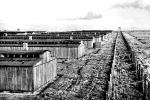 |
|
SEPTEMBER 1941
1 September: In Germany Jews were forbidden to leave their residence. 1 September: The Netherlands: Jewish children were excluded from public schools. 1 September: Hitler ordered that all Jews over the age of six in occupied Europe must wear a "Star of David" on their clothes. 2 September: Mass executions in Ostrog (2,200 Jews), Olynka (2,000 Jews), Polonne (682 Jews) in the Wolhynia region, and 800 Jews in Stryj (Distrikt Galizien). 3 September: First use of Zyklon B gas at Auschwitz. 3 September: Russia called up all men aged 18 or over for military service. 4 September: Soldiers of the Legion of French Volunteers left Paris to join the German army on the Eastern Front. 5 September: Mass execution of 2,200 Jews in Vinnitsa. 6 September: Establishing of the Vilnius Ghetto. 8 September: Leningrad was surrounded by German and Finnish troops. 8 September: First use of U.S. B-17 Flying Fortress bombers by the British in a mission targeted at Norway. 8 September: 600,000 ethnic Germans in the Volga region were exiled to Siberia in fear of fifth column activities. 9 September: The "Jewish Code" was released in Slovakia. Jews had to wear a yellow armband bearing th "Star of David". 11 September: Roosevelt ordered the U.S. Navy to shell German and Italian ships within U.S. territorial waters. 15 September: Top priority for the development of guided rockets at Peenemünde (Germany). 16 September: OKW chief Keitel ordered to kill 50-100 Communists in retaliation for each killed German soldier in the occupied countries of East Europe. 16 September: Allies occupied Tehran. The Shah of Persia, Reza Shah Pahlevi, abdicated. His Allied friendly son, Mohammad Reza, replaced him. 17 September: First death penalties in Germany for following foreign radio programmes. 17 September: Beginning of general deportations of German Jews to "the East" (Poland). 18 September: 200 patients from the Novinki (near Mogilev) mental home were murdered in a small bath house using vehicle exhaust gas. 18 September: Roosevelt asked for appropriations of $5.9 billion for Lend-Lease. 19 September: “Great Action” in Vinnitsa. SS and German police killed about 10,000 Jews from the town and neighbouring villages. The same day Sonderkommando 4a executed 3,145 Jews in Zhitomir. 19 September: In Germany all Jews older than 6 years had to wear a yellow "Star of David" in public. 19/20 September: Kyiv was occupied by the XXIXth German Army Corps and the 6th Army. 22 September: First transport of 3,200 Rumanian Jews from the Vertuzhany camp to Ukraine. 23 September: Charles de Gaulle announced in London the formation of a national committee as the legitimate French government in exile. 24 September: The USSR joined the "Atlantic Charter". 25 September: The end of the “Jewish Action” in Kherson. More than 8,000 Jews were executed. 25 September: The remaining Jews of Mogilev were ordered to move into a ghetto at the Dubrovenka Bridge within 5 days. 25 September: German forces cut off the Crimea from the rest of Russia. 26 September: The Battle of Kyiv ended. 27 September: Heydrich became "Reichsprotektor" for the occupied Czech Republic. 27 September: First set of "Liberty ships" were launched in the U.S. 28 September: Allied representatives met in Moscow. 29 September: In Kyiv all Jews were ordered to assemble "for deportation". The same day the Germans started to shoot them in the Babi Yar ravine. Philip Bouhler and Viktor Brack from the Führer’s Chancellery met Globocnik in Lublin and certainly discussed "Aktion Reinhard" and the transfer of personnel, then they inspected the Airfield Camp. The Nazis decided to use factory buildings in Poniatowa as a camp for 25,000 Soviet POWs. Sonderkommando 4a troops annihilated 30,000 Jews of Berdichev (Ukraine). The Germans set up a factory at 134 Janowska Street in the suburbs of Lviv (Janowska forced labour camp). Between September 1941 and October 1943, mass shootings were carried out at Blagowshtchina Forest (Maly Trostinec). |
 |
|
OCTOBER 1941
1 October: The Siedlce Ghetto was closed. 1 October (Yom Kippur): Mass executions of Jews in Brzezhany (about 600 people), and Khorostkow (Distrikt Galizien) (150 people). That day in 119,000 Jews were registered in Lviv (Lwow). 1 October: The next wave of extermination actions in Vilnius (Wilna). Until the end of October 33,500 Vilnius Jews were murdered at Ponary. 2 October: The Battle of Moscow began. 2 October: 2,273 people were murdered in Mogilev on 2 and 3 October 1941. 2 October: The German Messerschmitt ME163A rocket aircraft set a new speed record of 623 mph. 3 October: The mass murder of Kyiv Jews ended. According to the "Operations Situation Report of Einsatzgruppe C" of 7 October 1941, the Germans claimed that 33,771 Jews had been shot. 4 October: Marshal Ion Antonescu ordered the resettlement of all Jews from Bukovina to Ukraine. Beginning of the deportation of about 10,000 Jews from the Sokiriany camp in Bukovina. 6 October: SD units killed more than 2,000 Jews in Nadworna (Distrikt Galizien). 8 October: Auschwitz-Birkenau: Start of the construction works. 8 October: Mass execution of Jews in Human. Among 6,000 victims were 600 Soviet Jewish POWs. 8 October: Liquidation of the Vitebsk Ghetto. 16,000 Jews were killed. 10 October: RSHA conference on which the decision was made to deport Reich Jews eastward where they would be held in camps. 10 October: Terezin (Theresienstadt) was first mentioned as KZ in a Nazi document. 10 October: Reinhardt Heydrich stated at a conference on “Jewish questions”, held in Praha (Prague) on that day, that the heads of the "Einsatzgruppen" B and C, Nebe and Rasch, “could take Jews into the camps for communist prisoners in the operational area (Russia). According to a statement from SS-Sturmbannführer Eichmann this was already in progress". 11 October: 448 Jews were killed in Belgrade. 11 October: Establishment of the Czernowitz Ghetto. 12 October: German troops approach Moscow. Partial evacuation of the town. 12 October: Mass execution of Jews in Stanislawow (Distrikt Galizien, today Ivano-Frankovsk). SD, and German and Ukrainian police units killed 7,500 - 10,000 people. 13 October: Himmler met F. W. Krüger and Globocnik in Lublin. 13 October: 20.000 Jews were killed in Dnepropetrowsk. 14 October: Start of the deportations of German Jews from the "Reich", at first to Terezin (Theresienstadt), camouflaged as "Reichsaltersheim" (old peoples' home of the Reich). More than 42,000 Jews should follow. 15 October: According to the report by Einsatzgruppe A in Lithuania from 22 June 1941, 71,105 Jews were executed. 15 October: Jews from Austria (Wien) and Germany were deported to ghettos in Kowno, Lodz, Minsk, and Riga. 15 October: Between this day and 21 February 1942, 58 deportation trains, carrying in total more than 58,000 deportees (including 5,000 Sinti and Roma) from Vienna, arrived in the Lodz Ghetto. 16 October: Mass executions of Jews in Kozowa (500 victims), and Kosow (Distrikt Galizien) (900 victims). 16 October: The Japanese Prime Minister Prince Fumimaro Konoye resigned. General Hideki Tojo became Prime Minister. 16 October: Petain ordered the arrest of the former French prime ministers Daladier, Blum, and Reynaud. 17 October: SD and Ukrainian police executed 1,200 Jews in Kosow (Distrikt Galizien). 17 October: All U.S. merchant ships in Asian waters were ordered to dock at friendly harbours. 18 October: Tojo became Japanese Prime Minister. 19 October: 3,726 Jews were killed in Mogilev. 20 October: Hans Frank held a conference in Krakow, on which Wächter commented "that an ultimately radical solution to the 'Jewish Question' is unavoidable". 23 October: Prohibition of emigration of Jews from the "Reich". 23 October: Between 23 and 25 October 1941, Himmler visited Mogilev and inspected the new labour camp. 23 October: French General de Gaulle requested that the French Resistance stop assassinating German soldiers to avoid German retaliation against French civilians. 23 October: 19,000 Jews murdered in Odessa. 24 October: German troops captured Kharkov. 25 October: Amtsgerichtsrat Dr. Alfred Wetzel, responsible for Jewish affairs at the Ministry for the Occupied Eastern Territories, wrote to Heinrich Lohse (the Reichskommissar Ostland) with a proposal, advanced by Brack, to use Dr. Widmann’s gas vans in Riga to kill Jews unfit for work. 25 October: The Riga Ghetto was estalished. 25 October: The British battleship HMS Prince of Wales left for Singapore. HMS Prince of Wales was desginated the flagship of the Far East fleet. 27 October: British Lord Louis Mountbatten was appointed director of Combined Operations. 28 October: Massacre in Lachowicze. 2,000 Jews were killed. 28 October: About 750 Jews were killed in Bolechow (Distrikt Galizien). 28 October: 9,000 Jews were killed at Fort IX near Kovno. 30 October: 4,000 of 4,500 Jews of Neswish were killed. The remaining 500 were imprisoned in a ghetto. 30 October: The U.S. gave Russia a $1 billion interest free loan in order to buy Lend-Lease equipment. During the course of his visit to Mogilev, Himmler discussed with Bach-Zelewski and the commander of the Polizeiregiment Mitte, Max Montua, “solutions to the Jewish problem”, other than shooting. Schwarz and Oberhauser were the first SS men to arrive in Belzec. End of October the first T4 members were sent to Lublin to install and operate the three extermination camps of "Aktion Reinhard". The executions site at Blagowshtchina Forest (Maly Trostinec) was moved to Shashkowa Forest. Here more than 50,000 people were murdered. SS-Sturmbannführer Karl Streibel became commander of Trawniki. 35,000 Jews were shot in Odessa (Ukraine). In October about 112,000 Jews were killed only in Ukraine and Eastern Galicia. |
 |
|
NOVEMBER 1941
1 November: Belzec: Construction works began. 3 November: The German army captured Kursk. 7 November: First day of mass executions in Rowno (today Rivne / Ukraine). Until 9 November SD and Ukrainian police killed about 17,500 Jews. 7 November: 12,000 Minsk Jews were killed in Tuschinka. 7 November: The Netherlands: Jews had to obtain a permit to travel or move. 7 November: Japanese Admiral Yamamoto set the date for the attack on Pearl Harbor on 7 December. 7-8 November: Killing of 21,000 Jews in the Sossenki Forest near Dwinsk, and more than 3,000 in Pogulanka near Dwinsk. 8 November: The German civilian administration issued the order to establish a ghetto in Lviv (Lwow). 10 November: The Japanese fleet, charged with attacking Pearl Harbor under Admiral Nagumo, left Tokyo. 10 November: In Kamionka Strumilowa (Distrikt Galizien) SD units shot 400 - 500 Jews who officially were called “people not being able to work”. 11 November: The U.S. extended Lend-Lease to include the Free French. 13 November: A German submarine sank the British aircraft carrier "Ark Royal". 13 November: The U.S. Congress revised the Neutrality Act of 1939 to allow U.S. merchant ships to unload munitions in British ports. 14 November: The British Aircraft carrier Ark Royal sank near Gibraltar after sustaining damage by a German submarine the day before. 20 November: Deportation transports to Minsk were stopped about 20 November 1941 because of the supply crisis of the "Army Group Centre". 20 November: Killing of 20,000 Minsk Jews in Tutschinka. 20 November: During the so-called "Jäckeln-Aktionen" 30,000 Jews were killed at the Rumbula Forest near Riga. These killings lasted until 7 December 1941. 23 November: Mass execution of 500 Jews in Drohobycz (Distrikt Galizien). 24 November: Establishment of the Terezin (Theresienstadt) Ghetto. 140,937 Jews from Bohemia and Moravia were deported to Terezin until 20 April 1945. 33,539 of them died there, 88,196 were sent "further to the East". 24 November: German forces withdrew from Rostov. 25 November: In Germany the denaturalization and expropriation of Jews destined for deportation became legal. 26 November: The Japanese fleet assembled at the Kurile Islands. 27 November: The last Italian troops in Ethiopia surrendered to British troops. 29 November: Mass execution of 800 Jews in Boryslaw (Distrikt Galizien). 30 November: Mass shooting of Latvian and German Jews near Riga. 30 November: First successful use of air-to-surface radar when a British bomber found and sank the German submarine U 206. In mid-November, the Topf & Söhne Company of Erfurt received an order to construct a large crematorium at Mogilev. The Minsk Security Police and the SD established a forced labour camp in the village of Maly Trostinec. Construction works in Chelmno. The first group of Jews from Prague arrived in Terezin. The Einsatzgruppe B reported 45,476 killed Jews. Deportations and death marches from the Bukowina ended, e.g. from Czernowitz 30,000, from Dorohoi 5,384. Bosnia: All 14,000 Juden were deported to camps; e.g. from Sarajewo and surroundings to Kruscica. From there 4,000 women to Loborgrad, 4,000 men to Jasenovac, and 6,000 children to Staro Gradiska. 252 Jews from Essen were deported to Lodz. 489 Jews from Düsseldorf were deported to Minsk. 1,200 prisoners from KZ Buchenwald were brought to the euthanasia killing facility Bernburg and gassed. |
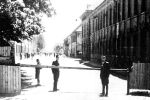 |
|
DECEMBER 1941
1 December: Deportation of 1,000 Jews from Stuttgart (assembling place: Killesberg) to Riga-Jungfernhof. 2 December: German units reached the outskirts of Moscow but were thrown back by Soviet troops. 3 December: Establishment of the KZ Jungfernhof in Latvia. From 15 November 1941 until 14 December 1942 Jews arrived from Germany, between 23 November 1941 and 6 February 1942 Jews from Wien arrived here, officially sent to Riga. 4 December: Special criminal law (martial law shootings) for Poles and Jews in the Polish areas annexed to the Reich. 5 December: In Horodenka (Distrikt Galizien) SD, German gendarmerie and Ukrainian police executed 2,600 Jews. 5 December: Good-will pact between the USSR and the Polish Exile Government in London. 6 December: In Lviv (Lwow) an “action against old and not being able to work people” began. About 3,000 Jews were executed. 6 December: Great Britain declared war on Romania, Finland, and Hungary. 6 December: Start of the Soviet counteroffensive near Moscow. 7 December: The first transport of Jews arrived at the Chelmno death camp. About 700 Jews from Kolo in the "Warthegau" were deported to Chelmno. 7 December: Herbert Lange became the first commandant of Chelmno. First gassings there (first phase). 7 December: Japanese air raid on Pearl Harbor. 8 December: The U.S. and Japan mutually declared war. 10 December: Japansese troops attacked the Philippines (Bataan Island). 10 December: The British battleship Prince of Wales sank. 11 December: Hitler's declaration of war on the U.S. 12 December: Hitler took the fundamental decision for the "Final Solution of the Jewish Question" at a meeting of his Reichs- and Gau-leaders in the Reich Chancellery in Berlin (Christian Gerlach). 12 December: The ship "Struma" left Romania for Palestine, carrying 769 Jews. Later British authorities denied its passengers to disembark. In February 1942, it sailed back into the Black Sea where it was sunk by a Soviet submarine. 12 December: Jews were prohibited to use public telephones. 14 December: Japanese troops invaded Burma. 18 December: Severely handicapped Jews were no more allowed to get a card for handicapped persons. 19 December: Hitler became commander-in-chief of the Wehrmacht. 21-31 December: In the Bogdanowska camp 54,000 Jews were killed. Only 200 survived. 22 December: Roosevelt and Churchill agreed on basic rules for the planned United Nations Organization. 22 December: Wirth took charge of Belzec. 23 December: In Kolomyja 1,200 Jews having foreign passports were arrested and killed. 25 December: Japanese troops took Hong Kong. 29 December: German troops retreated from the Crimea. 27,000 Jews were killed in Riga; among them the Jews of the first deportation transports from Germany (e.g. Stuttgart). The first trickle of T4 personnel appeared for duty at Belzec. An armed Jewish underground organization was established in the Minsk Ghetto. All 1,000 Jews of Estonia were killed. |
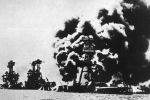 |
© ARC 2006